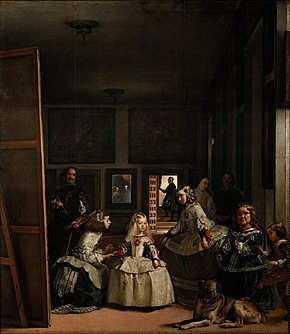Painting
![]()
Painter and paint are redirects to this article. See also painter (disambiguation). For the Dutch football player, see Donyell Malen.
![]()
Kunstmaler is a redirect to this article. See also: The painter.
Alongside architecture, sculpture, graphics and drawing, painting is one of the classic genres of the visual arts. While sculpture and architecture produce three-dimensional works, painting as well as graphics and drawing are usually two-dimensional works. Performers of painting are called painters or art painters. In contrast to drawing, this is done by applying wet paint to a painting surface using brushes, palette knives or other tools. These techniques are grouped under the term painting techniques. Printing techniques are not usually counted as painting techniques, even if wet paint is used in the process.
In addition to panel and wall painting, a further distinction is made between glass and book painting and painting on clay, ceramics (e.g. Greek vase painting) or other surfaces (paper, plastic).
Painting can look back on a long history worldwide. The oldest evidence of painting includes cave and rock paintings in Europe, America, Asia and Australia.

Las Meninas , Diego Velázquez, 1656-1657
Basic elements of painting
The basic elements of paintings are intensity, color and hue, and rhythm. For contemporary art paintings, non-traditional basic elements are additionally described. The intensity of a painting is defined by shading, contrast, and the use of adjacent elements with different color intensities. The juxtaposition of pictorial elements with the same color intensity can only produce symbolic differentiation. The perception of color and hue is subjective, but can produce culturally different psychological effects. For example, the color black is more associated with sadness in the West, while the color of mourning is white in the East. There are numerous theories of color theory by famous artists, scientists, and authors such as Goethe, Kandinsky, and Newton. Rhythm is abstractly defined in the painting as a pause within a sequence and describes the distribution of shapes, colors and shades. Non-traditional basic elements were introduced by modern artists and include techniques not captured by traditional basic elements. These include collage or the use of materials such as sand, straw or wood to impart texture.
Painting Techniques
→ Main article: Painting technique
The preferred painting techniques in antiquity were encaustic and tempera painting. Painting was done on wood, clay (vase painting), stone or on the fresh plaster (see fresco painting). Due to the small amount of archaeological evidence, the color spectrum of antiquity can be reconstructed only very inadequately. However, it has been observed that the colours red and blue have been best preserved.
Other examples of painting techniques used throughout history include fresco painting, tempera painting, oil painting, watercolour painting and gouache painting. In modern painting, newly developed binders are constantly expanding the possibilities of expression. An alternative or supplement to oil paint is acrylic paint, which was introduced for artistic use in Europe around 1960 and dries quickly while retaining its luminosity.
Questions and Answers
Q: What is painting?
A: Painting is using colors to create visual art.
Q: What are some types of paints used in art?
A: Watercolors, acrylics, and oils are commonly used in painting.
Q: What are some other tools artists use to create art besides paint?
A: Some artists use pencils, chalk, or charcoal to create their art.
Q: Where are famous paintings often displayed?
A: Famous paintings are often displayed in art galleries, such as the National Gallery in London or the Louvre in Paris.
Q: Is it necessary to go to a famous art gallery to view art?
A: No, there are private art galleries in many cities around the world where people can view art.
Q: What is the difference between drawing and painting?
A: In drawing, a single layer creates the entire image, while in painting, multiple layers are painted over each other to create the final image.
Q: What are the four basic stages of painting?
A: The four basic stages of painting are preparation, divide, layer, and touchup.
Search within the encyclopedia